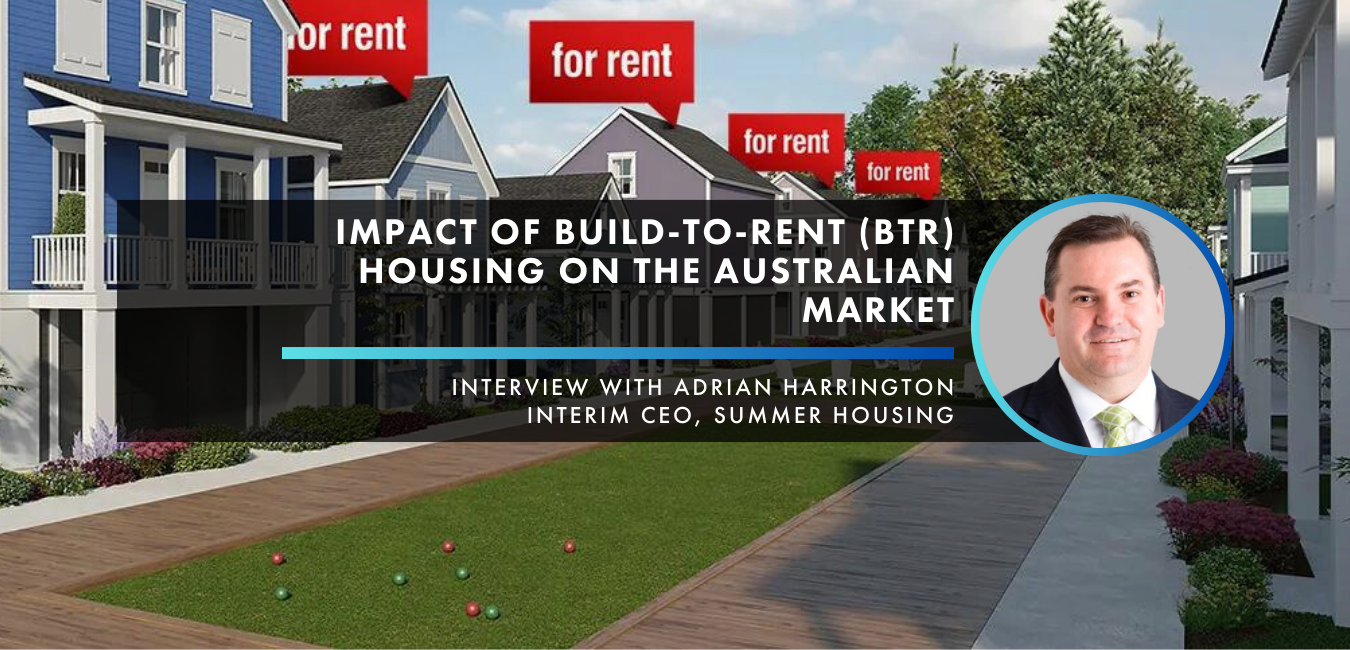FuturePlace Interview Spotlight, Adrian Harrington
FuturePlace recently interviewed Adrian Harrington, Interim CEO, Summer Housing, and Past Chair, National Housing Finance and Investment Corporation (NHFIC) & Australian Housing and Urban Research Institute (AHURI), where he shared his insights on the transformative impact of Build-to-Rent (BTR) housing in Australia. Addressing demand, affordability, and tax changes, he emphasises BTR’s potential to alleviate the housing crisis and anticipates insights from the BTR Summit for sector growth and consumer appeal.
FuturePlace: Could you please tell me more about your role and responsibilities in Summer Housing?
Adrian Harrington: In October 2022, I was appointed as a Non-Executive Director of Summer Housing. However, in March 2023, I assumed the role of Interim CEO to spearhead the implementation of the transformation plan that the Board had approved. The primary focus of this plan was to revamp the organisation’s structure and bolster its systems and processes to accommodate the substantial growth in its portfolio. Summer Housing now has over 390 SDA apartments in operation, with an additional 40 in the pipeline.
After five months as the Interim CEO, in August 2023, Stuart Miller assumed the role of the new CEO, taking the reins to build upon the progress achieved during my tenure. His leadership will guide Summer Housing into the next phase of evolution, considering the ongoing growth and evolution of the SDA sector.
With the completion of my role as Interim CEO, I will resume my position as a Non-Executive Director on the board, continuing to contribute to the organisation’s strategic direction and furthering its mission of providing high-quality housing for people with disabilities.
FuturePlace: What do you believe is driving the interest and heightened activity in BTR from an asset owner and investors perspective?
Adrian Harrington: There are several factors driving the heightened interest in BTR from both asset owners and investors’ perspectives:
- Changing preferences: Lifestyle changes, affordability issues, and urbanisation have led to an increasing number of people opting to rent rather than own a home. Homeownership rates for certain age groups have significantly decreased over the years.
- Strong demand: Population growth, supported by net migration numbers, continues to drive demand for housing, including rental properties.
- Scalability and efficiency: BTR developments often involve multiple apartments within a single project, allowing for economies of scale in the delivery of housing and more efficient, higher quality property and facilities management.
- Inflation hedge: The apartment sector has proven to be a good hedge against inflation. The ability to adjust rents quickly in inflationary environments makes BTR an attractive avenue for investors to generate and protect income streams.
- Diversification: BTR offers a chance for investors to diversify their portfolios, which have traditionally been heavily weighted towards office, retail, and industrial properties.
- Addressing issues in other sectors: The rise of online retailing and work-from-home arrangements has led investors to question the composition of their portfolios and seeking a greater exposure to alternate sectors such as BTR.
- Lack of quality stock: Institutional investors are looking to capitalise on Australia’s lack of high-quality, institutional-grade residential rental accommodations, which BTR can provide.
- Tax and planning reforms: The Federal and State Governments have implemented tax and planning reforms to attract more investment in the BTR market, making it easier for foreign capital to participate.
- ESG considerations: BTR developments can incorporate affordable housing and have strong environmental and sustainability credentials, aligning with Environmental, Social, and Governance (ESG) factors, which are increasingly important in investment decisions.
FuturePlace: Do you see BTR as providing a meaningful solution to the Australian housing crisis?
Adrian Harrington: While BTR alone cannot fully solve the housing crisis, it can play a meaningful role in addressing it. By creating more rental apartments, BTR has the potential to deliver housing quickly and on a large scale, alleviating pressure on the rental market. Moreover, reputable BTR market players are developing high-quality, professionally managed properties that can enhance the overall rental experience and improve the reputation of the rental sector.
“The Australian housing crisis is complex and requires a mix of solutions, involving all levels of government working with the housing sector to address issues related to affordability, finance availability, supply constraints, and regional disparities.”
FuturePlace: Is affordable housing and the current rental crisis being addressed by BTR or what more can be done?
Adrian Harrington: Yes, BTR has a role to play in addressing affordable housing and the rental crisis, but it is not the only solution. The rental crisis involves a large number of households in need of housing, and BTR can help by providing rental apartments. However, it cannot fully meet the entire demand on its own.
The Federal Government’s National Housing Finance and Investment Corporation (NHFIC) has been working to address the housing crisis by providing long-term and low-cost finance to support the provision of social and affordable housing, principally through community housing providers. This complements the efforts of BTR in tackling housing issues.
FuturePlace: Do you think the changes in taxation by the government were made to attract more international players into the Australian BTR Market and is this a good thing for the sector?
Adrian Harrington: The recent tax changes by the Federal Government, such as reducing the Managed Investment Trust (MIT) withholding tax rate and increasing depreciation benefits for new BTR projects, are indeed aimed at attracting more foreign capital, particularly from global pension funds and insurance companies, into the Australian BTR market. These changes make it more appealing for international investors to participate in the sector.
This influx of foreign capital can have positive effects on the BTR market, including increased investment, more housing supply, and improved affordability. However, it is essential to strike a balance and ensure that the interests of local communities and renters are also considered.
FuturePlace: What are you looking forward to most in the upcoming BTR Summit?
Adrian Harrington: I am looking forward to the BTR Summit, which has gathered an impressive lineup of speakers representing various aspects of the BTR ecosystem. The Summit provides an excellent platform for discussions on development practices, financing strategies, product innovation, understanding customer needs, and refining the investment thesis for BTR projects.
As the BTR sector is still in its early stages, these discussions and exchanges of ideas are crucial for its continuous growth and success in Australia.
Additionally, I encourage participants to explore the possibility of a consumer-friendly name for the sector, moving-away from BTR. By doing so, we can enhance its appeal and establish better communication with renters, fostering a more inclusive and relatable product experiences.
BUILD TO RENT SUMMIT
Adrian will be speaking at the Build To Rent Summit, taking place on 18th October 2023 in Sydney. It bring together over 250 senior leaders representing developers, investors, city and government officials, architects, engineers, financiers and built world technology companies to discuss all the big issues.







